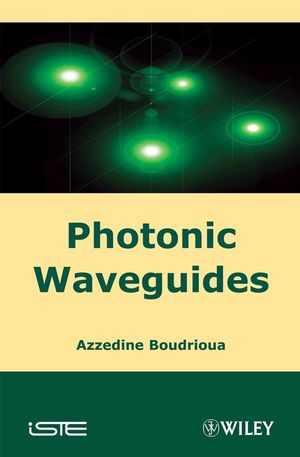Photonic Waveguides: Theory and ApplicationsISBN: 978-1-84821-027-1
Hardcover
320 pages
May 2009, Wiley-ISTE
 |
||||||
Foreword ix
Acknowledgments xi
Introduction xiii
Chapter 1. Optical Waveguide Theory 1
1.1. Principles of optics 2
1.1.1. Total reflection phenomenon 2
1.1.2. Parallel-face plate 4
1.2. Guided wave study 5
1.2.1. General description 5
1.2.2. Step index planar waveguide 7
1.2.3. Graded index planar waveguide 21
1.3. Channel waveguides 28
1.3.1. Effective index method 30
1.4. Light propagation in anisotropic media 33
1.5. Bibliography 35
Chapter 2. Optical Waveguide Fabrication Techniques 39
2.1. Optical waveguide fabrication techniques 40
2.1.1. Thin film deposition techniques 40
2.1.2. Substitution techniques 44
2.2. Integrated optic materials 59
2.2.1. Glass 60
2.2.2. Organic materials 60
2.2.3. Dielectric materials 61
2.2.4. Semiconductor materials 64
2.2.5. SiO2/Si materials 65
2.2.6. New non-linear crystals 65
2.3. Bibliography 69
Chapter 3. Optical Waveguide Characterization Techniques 77
3.1. Coupling techniques 77
3.1.1. Transversal coupling 77
3.1.2. Longitudinal coupling 80
3.2. “m-lines” spectroscopy 89
3.2.1. The experimental setup 89
3.2.2. Experimental arrangement 91
3.2.3. Measurement accuracy 93
3.2.4. Theoretical study of the effective index Nm 96
3.2.5. Waveguide parameter determination 99
3.3. Optical losses 107
3.3.1. Optical losses origin 107
3.3.2. Optical loss measurements 110
3.3.3. Characterization in near-field microscopy of optical waveguides 117
3.4. Bibliography 119
Chapter 4. Non-linear Effects in Integrated Optics 125
4.1. General considerations 126
4.2. Second harmonic generation 129
4.2.1. Second harmonic generation in the volume 131
4.2.2. Quasi-phase matching (QPM) 137
4.2.3. Fabrication of periodically poled structures 142
4.3. Second harmonic generation within waveguides 154
4.3.1. Overlap integral calculation 160
4.4. Non-linear optical characterization of waveguides 163
4.4.1. SHG setup 163
4.4.2. Second harmonic generation by reflection 165
4.4.3. Second harmonic generation in waveguides 170
4.5. Parametric non-linear optical effects 173
4.5.1. Parametric amplification 173
4.5.2. Optical parametric oscillation (OPO) 174
4.6. Laser sources based on non-linear optics 177
4.7. Bibliography 182
Chapter 5. The Electro-optic Effect in Waveguides 187
5.1. Introduction 187
5.2. The electro-optic effect 188
5.2.1. The case of LiNbO3 193
5.3. The electro-optic effect in waveguides 200
5.3.1. Analysis of the electric field distribution 202
5.4. Electro-optic measurement techniques 209
5.4.1. The Mach-Zehnder interferometer 209
5.4.2. The polarization change technique 211
5.4.3. Angular displacement of guided modes (AnDiGM) technique 213
5.5. Optical devices using the electro-optic effect 222
5.5.1. Phase modulators 223
5.5.2. Intensity modulators 225
5.6. Integrated optic setups using the electro-optic effect 235
5.6.1 Optimal design of the electrodes for integrated EO modulators 235
5.6.2. Integrated EO phase modulator 238
5.6.3. Integrated EO intensity modulator (Mach-Zehnder) 240
5.7. Modulation in optical networks: state-of-the-art 248
5.8. Bibliography 254
Chapter 6. Photonic Crystal Waveguides 261
6.1. Dispersion relation 262
6.1.1. Dispersion relation of an isotropic medium 262
6.1.2. Dispersion relation of an anisotropic medium 264
6.1.3. Dispersion relation in waveguides 265
6.2. Photonic crystals 267
6.2.1. Definitions 267
6.2.2. Bragg’s mirror 270
6.2.3. Photonic crystal geometries 272
6.2.4. 2D photonic crystal cells 273
6.2.5. Electron-photon analogy 276
6.2.6. Dispersion relation and band structures 278
6.2.7. Simulation methods 280
6.3. Photonic crystal fabrication techniques 290
6.3.1. Etching techniques 290
6.3.2. Ion and electron beam lithography 293
6.3.3. Laser processing 296
6.4. Examples of photonic crystal applications 300
6.4.1. Optical micro-sources (point defects) 301
6.4.2. Photonic crystal waveguides (linear defects) 302
6.4.3. Optical filter 303
6.4.4. Hetero-structures 304
6.5. Photonic crystals and non-linear optics 305
6.6. Bibliography 309
Conclusion 317
Index 321



